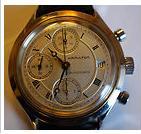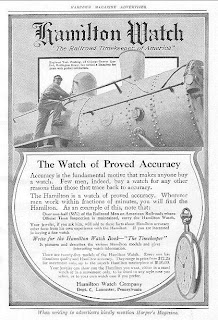Note: This is an update from an article posted in March, 2012. It focuses on Hamilton, because I specialize in this brand. I also have collected Gruens, Elgins, Bulovas, Walthams and a variety of Swiss watches. You can use the information herein for any of those brands of vintage watches.
Where Have All the Vintage Watches Gone?
What’s happened to the supply of used watches referred to as vintage or antiques? Several different situations have affected the supply. I list these below. With the factors I mention in mind, I’m at a loss to explain why prices for Hamilton Vintage watches remain so low. It seems odd to me that when a commodity’s supply diminishes the price remains stable and doesn’t increase. That’s what has caused me to address the valuation issue.
New collectors of Hamilton watches will find that a very high percentage of watches available on the Internet have come out of estates and garage sales. A backlog of old watches doesn’t exist, generally speaking. Several factors have dented the supply of older wristwatches.
Gold smelters in the 1970’s destroyed in excess 98% of all wind-up vintage watches. If you see a “production” figure of say 2000 units for a certain model, then maybe and I mean maybe, 20 of that model remain. They’ll be in various conditions from worn-out and not running to running and maybe in good shape.
My grandfather, uncles and father participated in this activity. They owned guild Jewelry Stores beginning in 1902. They sold many Rolex watches among other watches. If a customer came in for a newer 1960-70 watch, they took a trade-in of his old watch and tossed them in barrels. You read that correctly.
When the gold smelting began, they had employees haul those barrels to Southwest Smelting and had the gold leached out. My folks made a lot of money. As a side note, they smelted their entire Christmas inventory when gold reached $60, then again when it went into the $400 range.
Why did they do that to their customers? Because they could. I understood it even though I didn’t agree.
People have and continue to buy many vintage watches for parts. It’s difficult to find parts for old watches and many watchmakers only know how to change parts. They don’t know how to fix parts.
Collectors and hobbyists have also grabbed up as many items as possible. In 2012, the available inventory from estates and antique malls has started to disappear. You’ll also see churning, which in this case means buying, selling and then buying back. We’re dealing with a fairly static supply of watches with swings in demand based on the economy.
The first sellers of vintage Hamilton watches on the Internet market typically had an inventory purchased at NWCCA chapter meetings. An efficient market for vintage watches didn’t exist with the exception of four national conventions each year. Once eBay got started, people were in a quandary of how much to ask and how much to bid. The early sellers didn’t value their watches high enough considering demand.
What’s that watch worth today?
Two years ago, I bought a 1938 wristwatch for $135 plus shipping. That was considerably higher than the same model in the same condition would have sold for in an auction. I checked with Fast Fix Jewelry and they wanted $395 plus parts to clean, oil and adjust the watch. They also wanted four months to turn it around. Price disparity? I decided to have the dial restored, which cost $45 including shipping back and forth.
In June 2013, I bought the same model for $45 and shipping was free. The watch was in mint condition. I ask myself how is that possible.
If I didn’t know how to work on the movement myself, I would have to add $400 to the purchase price. If I asked someone to buy, service and restore the dial my cost would have run approximately $585. That’s a decent estimate of the value for a working, restored 1938 Hamilton watch in 2010. Not today.
Gold Prices in the 1970’s
After the United States deregulated gold in 1971, the price increased markedly, briefly reaching more than $800 per troy ounce in 1980. From 1980 to 2007, the price has remained in the range of $320 to $460 per troy ounce. The rising prices of the 1970’s encouraged smelting of anything with gold in it. That meant “gold-filled” watch cases. Why? The gold filled on top of brass and it was significant in amount. Solid gold also laid over brass, but in higher quantities. A $20 used wristwatch became a $200 piece of gold in 1974. My grandfather’s jewelry stores would give a customer a trade in allowance of $5 when the buyer surrendered their old watch for a new one. Those watches went into a barrel and prior to 1971, like other Jewelers selling Bulova Accutrons, no one thought anything of it.
Then came the on-rush. A firm called Southwest Smelting had a process for leeching the gold out of those watches. The barrels full of watches made their way to downtown Dallas, Texas. Off went what we call vintage watches. Who knew? If I could look into the future, I would have held on to my “used” 1957 Chevy.
Unless you just want a real vintage watch (and many people do), then consider a new Hamilton watch. Make sure it has a mechanical movement. Otherwise, you’ll pay $450 -$750 and get a $30 quartz movement.
Let’s take a look at if the decades have been fair to Hamilton wristwatches:
If you bought a watch in 1938, for example, a $90 watch would have an impact on your purchasing power given your current circumstances. You’ll have to imagine going into a jewelry store in the mall, looking at a solid gold model and writing a check for it.
In later years, you could use a hypothetical example similarly.
 |
| Hamilton Chronometer |
You’ll need to look at some recent sales from eBay, to find a buyer-seller gauge for the value of your watch. Some prices, in my opinion, are not representative of a typical exchange, but that’s irrelevant. Hamilton wristwatches have not been a “good investment”.
If you want one, then buy it for its novelty. Some of my Hamilton wristwatches are exceptional. With the exception of the improvements made in sealing cases, the movements and cases are as good and in some cases better than watches costing ten times as much.
To summarize:
1. The supply of Hamilton wristwatches have not gone up in market value even though the supply has almost disappeared.
2. Prices in 2013 are lower than most collectors would expect – myself included.
3. Value-in-use far exceeds any appreciation you will probably ever see in price.
If you just want a retro-looking watch, visit the Hamilton Company web site.
Copyright 2006-2017 | All Rights Reserved

